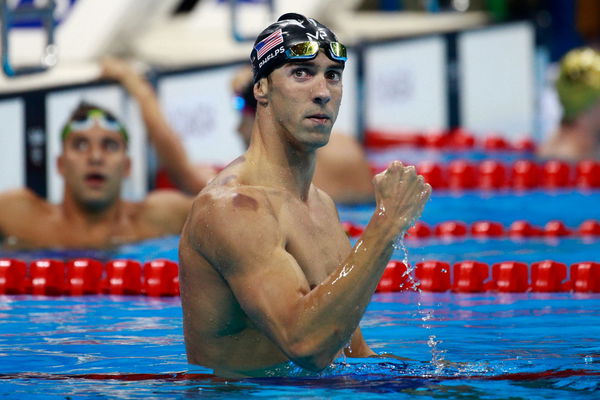
via Getty
RIO DE JANEIRO, BRAZIL – AUGUST 09: Michael Phelps of the United States celebrates winning gold in the Men’s 200m Butterfly Final on Day 4 of the Rio 2016 Olympic Games at the Olympic Aquatics Stadium on August 9, 2016 in Rio de Janeiro, Brazil. (Photo by Adam Pretty/Getty Images)

via Getty
RIO DE JANEIRO, BRAZIL – AUGUST 09: Michael Phelps of the United States celebrates winning gold in the Men’s 200m Butterfly Final on Day 4 of the Rio 2016 Olympic Games at the Olympic Aquatics Stadium on August 9, 2016 in Rio de Janeiro, Brazil. (Photo by Adam Pretty/Getty Images)
Injuries are common in sports; especially when playing competitive sports professionally, athletes go through intense training and routines, sometimes in recovery from blows received during the game. Legendary swimmer Michael Phelps is one of the many sportspersons who adopted a wide variety of healing practices to feel better. Back in his prime, the icon often sported purple spots on his back, which were a result of “cupping”.
ADVERTISEMENT
Article continues below this ad
Cupping has been the go-to healing technique for many athletes. While the ancient healing practice is hailed by many for its efficient results, Phelps’ personal trainer once revealed the effects of cupping and his thoughts on it.
Just a recovery modality, said Michael Phelps’ trainer
While many athletes swear by its benefits, including legendary swimmer Michael Phelps, his trainer had no particular feelings about it. Keenan Robinson, the swimmer’s personal trainer, once revealed that he didn’t feel that the method was special.
Cupping is an ancient healing practice where special ‘cups’ are placed on the skin. These cups gently suck on the skin, utilizing either heat or an air pump. The procedure results in purple spots, as it often ruptures the capillaries beneath the skin surface.

via Getty
Swimming – Olympics: Day 7 Michael Phelps of the United States dives in at the start of the Men’s 100m Butterfly Final during the swimming competition at the Olympic Aquatics Stadium August 12, 2016 in Rio de Janeiro, Brazil. (Photo by Tim Clayton/Corbis via Getty Images)
Phelps swore by the method, asking for a cupping session before every meeting. In fact, many sportspersons have adopted cupping as a method of recovery. However, Robinson had a fun way to describe it. Talking about Phelps’ back, he exclaimed, “Because this recovery modality shows blemishes on his skin, he walks around and looks like a Dalmatian.”
ADVERTISEMENT
Article continues below this ad
So does cupping hold any scientific benefits to it? The answer is a bit complicated. Many argue that it has more of a placebo effect. The trainer acknowledged that the legendary swimmer did it to feel good.
ADVERTISEMENT
Article continues below this ad
However, he ensured that they had an educated approach to recovery methods like cupping. He stressed the importance of both psychological and physiological intents to recover. Therefore, the answer might differ from individual to individual. What are your thoughts about cupping?
Watch this story: From lactic acid to webbed feet – here’s how Michael Phelps’ heart rate edges him over other competitors
ADVERTISEMENT
ADVERTISEMENT
ADVERTISEMENT
ADVERTISEMENT

